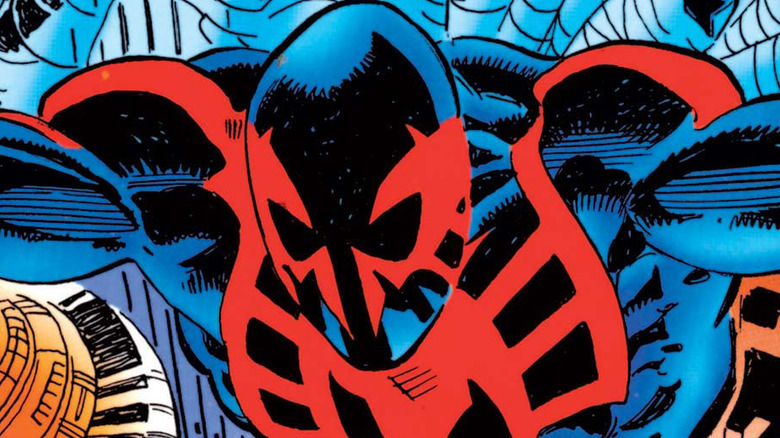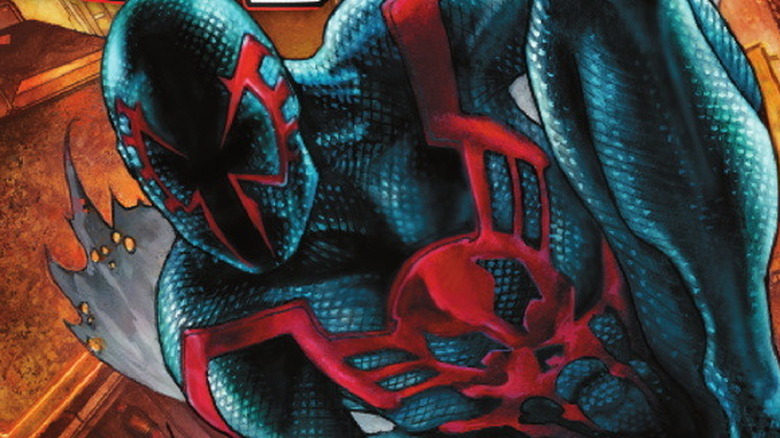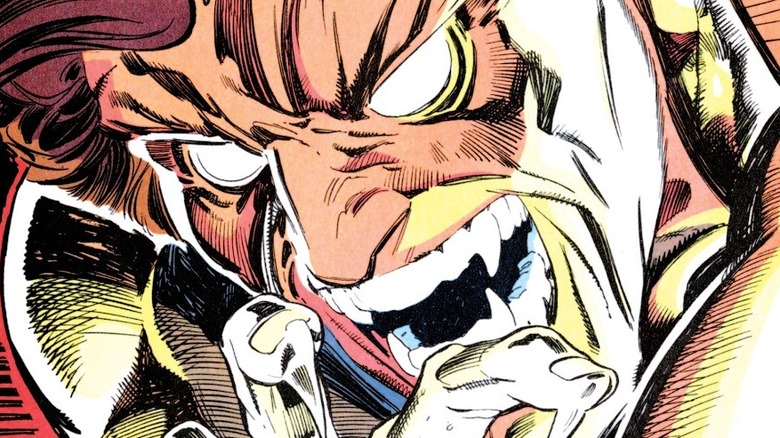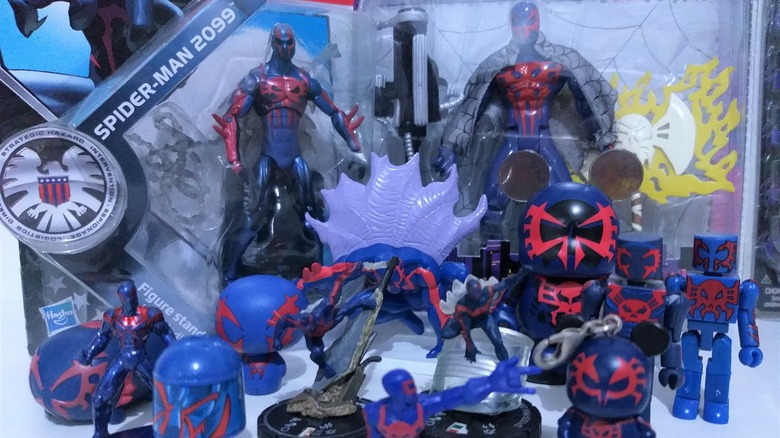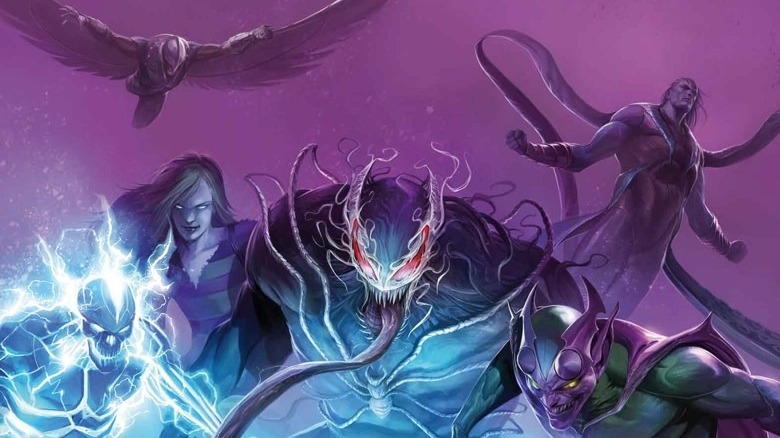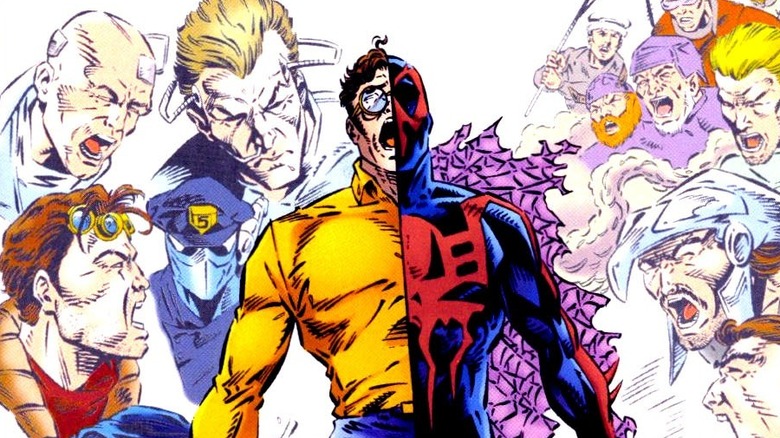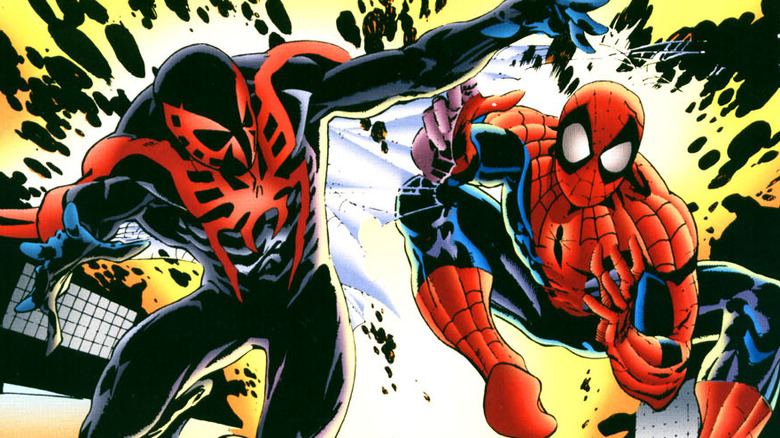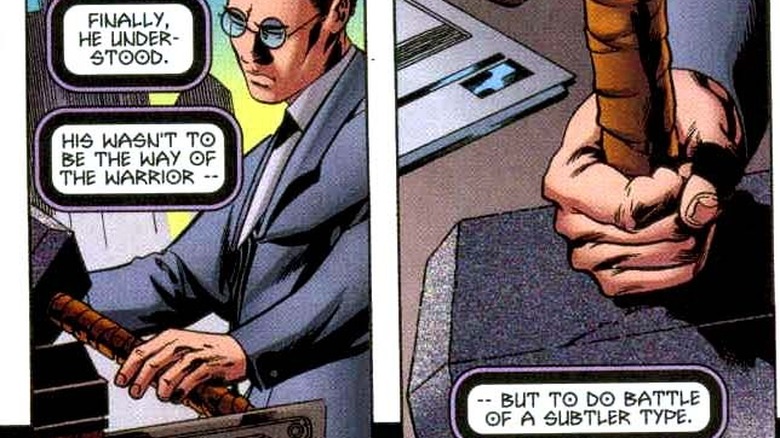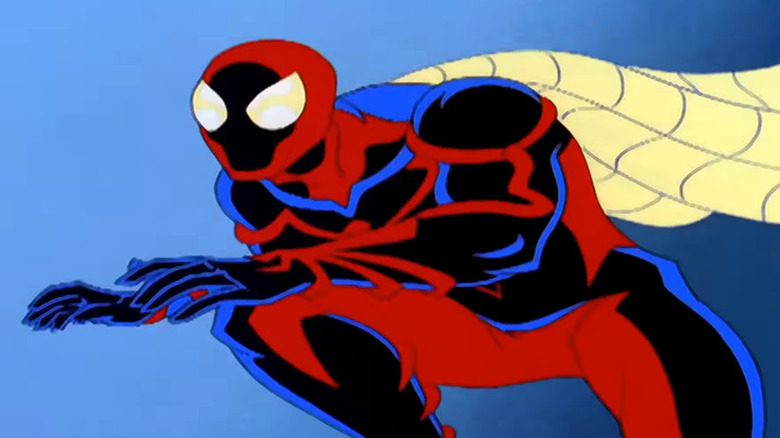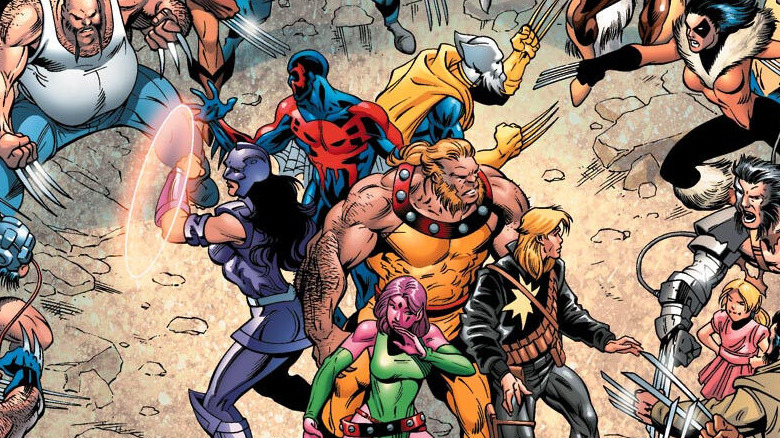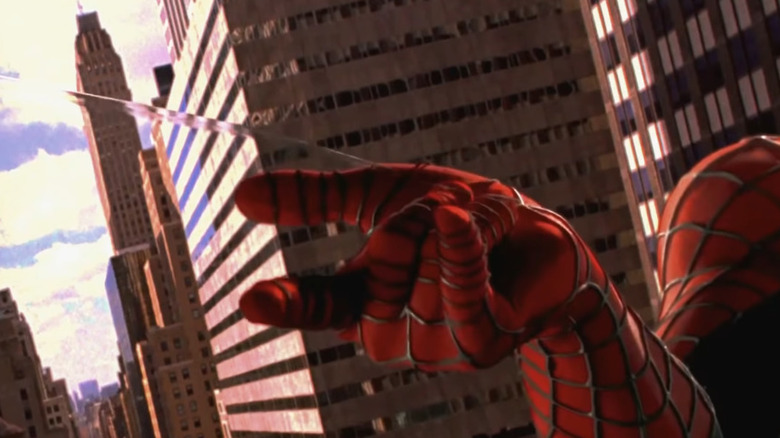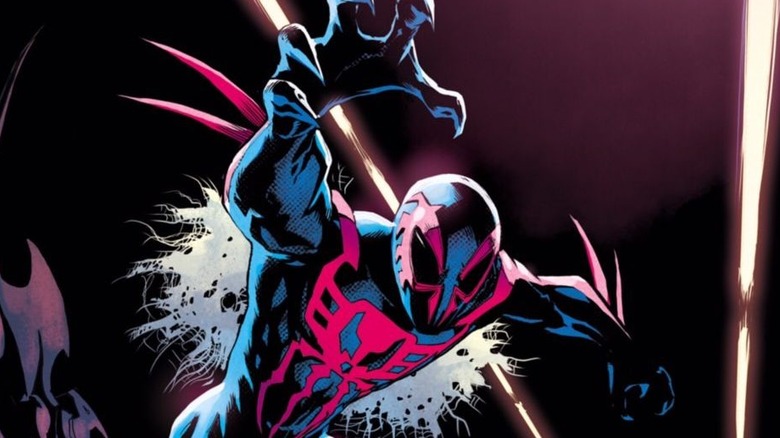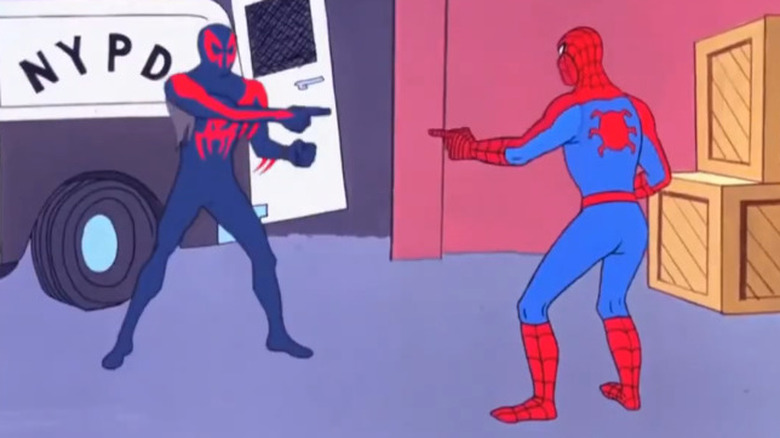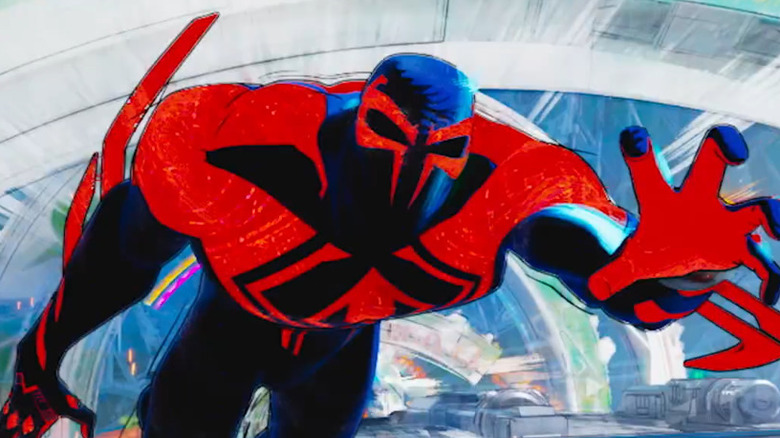The Untold Truth Of Spider-Man 2099
Since his debut in the pages of 1962's "Amazing Fantasy" #15, Spider-Man has captivated legions of fans all over the world, and with good reason. Introduced as an awkward bookworm with a never-ending stream of life problems, Peter Parker was unique among the clean-cut, larger-than-life superheroes of the Silver Age. This made him particularly relatable for the comics-reading teenagers of the era, who had financial and relationship woes of their own. It also helped that the wall-crawler's iconic costume covered him from head to toe, giving no hints about his identity; when he's suited up, Spider-Man could be anyone, a fact that resonated with readers quite well.
Over the years, many have taken up the mantle of Spider-Man in the comics, staying true to the character's core while infusing it with their own unique abilities, personalities, and struggles. And while the idea of multiple Spider-people has become a pop culture mainstay because of comic book crossover events and movies like "Spider-Man: Into the Spider-Verse," there was a time when Marvel Comics established that only one person was destined to (reluctantly) continue the wall-crawler's legacy: a brilliant scientist from a dystopian future with technological marvels, all-powerful corporations, and no superheroes. Here is the untold truth of Miguel O'Hara, the Spider-Man of the year 2099.
Miguel O'Hara: Marvel's first Hispanic and biracial Spider-Man
Back in 1992, Marvel Comics announced a new line of comics set a hundred years into the future. Originally advertised as "The Marvel World of Tomorrow" and "Marvel 2093," the official banner of the books ended up becoming "Marvel 2099."
The line kicked off with "Spider-Man 2099," cover-dated November 1992. Set in the technologically advanced city of Nueva York, the title followed the story of Miguel O'Hara, a brilliant but arrogant geneticist employed by top mega-corporation Alchemax. Tasked with creating superpowered corporate raiders to steal other companies' secrets, Miguel took inspiration from the original Spider-Man, but resigned after his boss Tyler Stone forced him to rush human trials. To stop him, Tyler tricked Miguel into taking a highly addictive drug (later revealed to be a ruse) that only Alchemax could distribute. Miguel attempted to revert his DNA, but a jealous colleague sabotaged his experiment, inadvertently causing Miguel to get spider powers.
While the concept of alternate Spider-Men certainly wasn't new in 1992 (due in part to the different versions of the wall-crawler introduced in the What If? series), Miguel represented many firsts in Spider-Man's publication history: He was the first "true" successor of Peter Parker, as well as the first Hispanic (Mexican) AND biracial person to officially call themself Spider-Man, debuting ahead of Miles Morales by nearly two decades.
Spider-Man 2099: The opposite of Peter Parker
Spider-Man 2099 was a co-creation of writer Peter A. David (also known as PAD) and artist Rick Leonardi, who worked as the creative team for a good part of the character's first run. In an entry on his website, PAD confirmed that he named Miguel O'Hara after his close friend, actor Miguel Ferrer.
An interview with Newsarama revealed more details behind the creation of Spider-Man 2099. PAD endeavored to zig where Stan Lee and Steve Ditko zagged: "Basically, I inverted the modern-day Spider-Man wherever I could. Current Spidey is chatty in costume, and reserved as Peter Parker. So I had Spider-Man 2099 be fairly mute in costume and a wiseacre as Miguel." Peter often works alone, while Miguel has a partner: Lyla, his holo-assistant programmed to look like Marilyn Monroe. Even Miguel's powers took a darker turn, along the lines of body horror: While Peter could still pass as a regular guy out of costume, Miguel has fangs and talons that could only retract when in contact with his own skin, as well as eyes so sensitive to light that he has to wear shades all the time.
Peter and Miguel also differed in terms of their hero's journeys. Peter is a good person perpetually atoning for a single act of selfishness. Miguel, on the other hand, donned the costume simply in order to evade capture and save his own hide, but eventually grew into his role as champion of the oppressed.
Spider-Man 2099's costume: Black or blue?
Spider-Man 2099 is, without a doubt, the most successful character out of the entire 2099 line — and a huge part of that is because of his costume. Designed by Leonardi, it featured no weblines and a simple three-color scheme: inverted eye lenses and a skull-themed spider symbol in red, against a black full-body suit with blue highlights.
Made out of unstable molecule fabric (UMF), the suit was highly resistant to damage, wrapping around Miguel's talons without ripping. It also had a tattered, web-like cape made out of light byte, enabling him to glide across short distances and land safely from great heights. There's actually an in-story reason for Miguel owning the suit prior to his lab accident. He bought it because he wanted something extra-durable to wear during the typically rough and rowdy Día de los Muertos (Day of the Dead) celebrations in his mother's homeland.
The costume has generated a fair bit of controversy among fans, specifically regarding what color it's supposed to be. While his holo-assistant Lyla outright calls it black, comic book coloring techniques end up making it look blue on both the covers and the interior art. Furthermore, an overwhelming majority of Marvel's official Spider-Man 2099 merchandise features the character sporting a decidedly blue or metallic blue suit. In a 2021 episode of the Amazing Spider-Talk podcast, Leonardi settled the debate: "I'm on team 'Superman's hair.' I mean, what color is Superman's hair? It's comic book black."
The more things change, the more they stay the same
PAD wanted to make Miguel O'Hara as different as possible from his predecessor, but he still had to establish some connective tissue between the two Spider-Men. This became evident in Miguel's rogues gallery: quite a few were all-new characters assuming familiar names in Spidey lore, often with a disturbing twist.
The Vulture of 2099 is a far cry from the decrepit, green-feathered technologist Adrian Toomes. This future predator of the skies sported a metallic silver costume — and, true to the spirit of a carrion bird, had no qualms about eating dead humans. Meanwhile, the Goblin of 2099 sought to usurp Spider-Man 2099's place as the defender of the downtrodden, and was secretly an ordained priest named Jennifer D'Angelo. The most noteworthy among Spider-Man 2099's foes is the acid-spewing Venom 2099: Kron Stone, the son of Miguel's boss, united with the still-surviving (and now vastly mutated) Venom symbiote. In an interview with Newsarama, PAD admitted that Venom 2099 was created solely to boost sales, as he was the most-requested villain from the fans: "So it was more or less, 'Okay, fine, you want it? You got it. Now buy the damned book.'"
The various follow-up series starring Spider-Man 2099 also introduced other villains who referenced classic Spidey foes. Electro 2099, for example, was an automated construction worker that achieved sentience and the ability to weaponize electricity.
Spider-Man 2099's personal life: Straight out of a soap opera
In another deliberate departure from the contemporary Spider-Man, PAD gave Miguel O'Hara a bigger nuclear family, albeit one that was far less warm and loving than Peter's. Miguel got along well enough with his brother Gabriel, though they clashed on a lot of things. Their mother Conchata was of Mexican descent, and was not above resorting to theatrics in order to emotionally manipulate her sons. Their father, George, was an abusive Irishman who left their family and remarried. As a child, Miguel showed exceptional aptitude in his studies, earning him a place at the Alchemax School for Gifted Youngsters. It was there where he met his future girlfriend Xina Kwan, as well as his future nemesis and bully Kron Stone.
Much later in his life, Spider-Man 2099 learned some truths that changed much of what he knew about himself. Eavesdropping on a conversation between his mother and his boss Tyler Stone, he found out that the drug that Tyler had slipped him when he tried to quit — which was the reason why he underwent the experiment that ultimately turned him into Spider-Man 2099 — was merely a simulation whose effects would have gone away after some time. More importantly, Miguel discovered that Tyler was his real father, not George. These revelations left Miguel devastated, and had a profound impact on his subsequent decisions both as a civilian and as a superhero.
Marvel legends collide: When Spider-Man 2099 met Spider-Man
In the 1995 one-shot comic book "Spider-Man 2099 Meets Spider-Man," the two time-displaced webslingers encountered each other under dire circumstances. Faced with a threat more than a hundred years away from Miguel O'Hara's own future, the two heroes worked together to avert the crisis that killed all the superheroes of the present day and led to the dystopian nightmare of 2099. In a sense, it confirmed that the 2099 universe was meant to be the "true" future of the Marvel universe.
When this book was released, Peter Parker was dealing with an identity crisis of sorts. The main Spider-titles were busy dealing with the infamous Clone Saga, a mega-event that featured the return of Ben Reilly, Peter's clone from the 1970s. PAD had a choice between using Peter or Ben as the contemporary Spider-Man of the story; in a Newsarama interview, he shared that he and Leonardi were "strongly advised" to feature Ben, who was planned to be revealed as the original Spider-Man all along.
PAD, however, didn't buy this a single bit, and rightly so. "My attitude was that [Ben] would never, ever last. And if we did go with Ben, then when Peter Parker returned to the fold as the one and only Spider-Man, then the crossover would just be this bizarre footnote rather than the definitive meeting I wanted it to be." And true enough, Peter ended up being named the genuine article when the Clone Saga concluded in 1996.
The worthy Spider-Man: Miguel O'Hara wields Thor's hammer
The entire 2099 line came to a halt in the late '90s, when financial woes forced Marvel to axe titles and let go of employees left and right. To Marvel's credit, they attempted to wrap things up in a neat little bow — and at the center of it was the character that started it all, accomplishing something that even the original Spider-Man couldn't do.
The one-shot "2099: Manifest Destiny" showed the surviving members of civilization in the aftermath of an alien invasion, trying to pick up the pieces. Helming these efforts to rebuild society was Miguel O'Hara, now CEO of Alchemax and married to his childhood sweetheart Xina. Miguel's team found and revived an unexpected relic from the past: Steve Rogers a.k.a. Captain America. Miguel gifted him with Thor's hammer, Mjolnir; however, in a space adventure that goes awry, Cap bequeathed the godly weapon to Miguel. Surprisingly, the semi-retired superhero was able to lift it, a fact that shocked even Miguel himself.
Despite being worthy of Mjolnir's power, Miguel wasn't physically transformed by the enchanted weapon. Instead, he used it to command the respect of humanity's leaders, his worthiness proof of his sound-decision making skills. Under Miguel's leadership, Earth continued to thrive; by the year 3099, humanity transformed into a powerful but benevolent force that no alien race dared to antagonize. Not bad for a former corporate stooge who never wanted to be a superhero in the first place.
Spider-Man 2099 almost had his own animated series
According to PAD, the first issue of "Spider-Man 2099" was "the highest-selling single issue of any comic [he'd] ever written, ever." This made the titular character ripe for cross-media adaptation — and for a brief period of time, he was positioned to have a Saturday morning TV show.
After the five successful seasons of "Spider-Man: The Animated Series," Saban Entertainment was tasked to work on a new Spider-Man cartoon for Fox Kids. However, due to the tangled web that was (and still is) Spider-Man's cinematic rights, Saban and Fox were not allowed to use any of Spider-Man's existing stories, though they could use Peter Parker/Spider-Man as the main character. The result was "Spider-Man Unlimited," a 13-episode series that wasn't quite as well-received as its predecessor. Set on Counter-Earth, it featured Peter Parker in a new costume designed specifically for the series, and pit him against the anthropomorphized animal soldiers of the High Evolutionary.
In the early stages of the show's development, however, the creators of "Spider-Man: Unlimited" briefly but seriously considered making a show about Miguel O'Hara. In response to an online comment, series creator Will Meugniot said: "Actually, Spider-Man 2099 was seriously considered, but Batman Beyond was already in the works, and had covered that territory pretty well." "Batman Beyond" was a 1999 cartoon starring Bruce Wayne's successor in the year 2039; in a way, it made sense that the creators of "Spider-Man Unlimited" didn't want to tread similar ground.
Spider-Man 2099's team-ups in comics and video games
Even without an ongoing book, Miguel O'Hara had amassed enough of a cult following to make sporadic appearances in various comics. A version of him appeared in 1998's "Avengers Forever" #12, which saw him fighting alongside Avengers from different realities against Immortus (one of the inspirations for He Who Remains, the main antagonist of the Disney+ "Loki" show). PAD was also briefly reunited with the character while he was writing "Captain Marvel" in 2002.
Another version of Miguel O'Hara became an unexpected addition to an X-Men-related book. In 2006's "Exiles" #75, the eponymous team of mutant dimension-hoppers ended up in the year 2099, meeting the Spider-Man of that era. Due to time-altering circumstances that changed the course of the future webslinger's life, he decided to join the Exiles, becoming part of the book's regular cast until issue 99.
Miguel was also slated to be part of "Marvel 2099: One Nation Under Doom," a game that was planned for a 1996 release before getting canceled. Still, he did pop up in a number of games, including Activision's "Spider-Man" game from 2001, 2010's "Spider-Man: Shattered Dimensions," and "Spider-Man: Edge of Time" from 2011.
Did Spider-Man 2099 inspire Sam Raimi's Spider-Man?
In differentiating Miguel O'Hara from Peter Parker, PAD gave the classic spider powers a unique twist. The present-day Spidey uses mechanical webshooters to swing around the city, scales sheer surfaces through some form of mysterious biomagnetism, and possesses an uncanny "spider-sense" warning him of impending danger.
Meanwhile, the Spider-Man of the future has spinnerets in his forearms, possesses small, sharp talons that function much like ice climbing picks, and accelerated vision that gives him a 360-degree view of his surroundings and allows him to dodge incoming threats. And there's a very good chance that Miguel's abilities sound familiar to you — that is, you've seen the Sam Raimi "Spider-Man" film trilogy. Even PAD himself noticed the similarities. "Actually, when you think about it, Spider-Man 2099 is more or less exactly what they did in the Sam Raimi's movie Spider-Man," he told GamesRadar, "although Miguel glided with the webbing on his back rather than swing on weblines."
However, based on the account of screenwriter David Koepp, Tobey Maguire's organic webshooters in that film weren't really inspired by Spider-Man 2099. In fact, they were carried over from James Cameron's original treatment, back when he was still slated to direct the film. Koepp kept it in, and Raimi was happy with it; the director believed that it made the hero's cinematic transformation more believable.
Back to the future (again and again and again)
Over the years, there have been multiple attempts to revisit the 2099 timeline, specifically with Spider-Man 2099 as the central character.
There was the failed "Timestorm 2009/2099" reboot, which made quite a few fundamental changes to the 2099 characters. Miguel in particular was reimagined as a young student, much like in Peter Parker's origin story. Spider-Man's next shot at a mainstream revival came in 2013, when he faced off against the Superior Spider-Man (Doc Ock's brain in Peter Parker's body) and ended up being stuck in the present day. This led to him starring in a new self-titled book in 2014. 2015 also saw a reboot of Miguel's title, as well as a new white costume for the hero. It lasted for 25 issues before the time-displaced hero was sent back to the future.
Coinciding with Marvel Comics' 80th anniversary, the world of 2099 was revisited once more in 2019, with Miguel teaming up with Peter Parker yet again in a few issues of the "Amazing Spider-Man" title.
Let's start at the beginning, one last time...
Since his 1992 debut, Spider-Man 2099 has maintained enough popularity to keep him from fading into obscurity. His appearances in various comic book crossovers have also helped him maintain a consistent, if not terribly prominent, presence in Marvel continuity. However, what really catapulted Miguel O'Hara into the mainstream public consciousness was his unexpected appearance in a bonus scene of an Academy Award-winning animated film.
In the same vein as many of the past decade's superhero blockbusters, 2018's "Spider-Man: Into The Spider-Verse" featured a special post-credits scene. In it, Miguel O'Hara (voiced by Oscar Isaac) is revealed to have been monitoring the events of the film, and is preparing to stop another multiversal threat. Using a reality-hopping wrist device created by his holo-assistant Lyla, Miguel leaves the world of 2099 and lands on Earth-67, home of the infamous meme-worthy Spider-Man from the '60s cartoon. The two Spider-Men proceed to recreate the popular pointing meme in an extended sequence. Evidence, well, points to Miguel playing a bigger role in the sequel, slated for release in 2023.
A more prominent role in Spider-Man: Across The Spider-Verse
On December 5, 2021, Sony Pictures debuted a short teaser trailer of "Spider-Man: Across The Spider-Verse," the sequel to the animated film "Spider-Man: Into The Spider-Verse." It showed Spider-Man 2099 significantly bulked up and sporting a new costume (different from the one he wore in the previous film's post-credit scene), apparently serving as an antagonist for Miles Morales (Shameik Moore). One year later, the first full trailer for "Across The Spider-Verse" was released on social media, confirming that Spider-Man 2099 would have a more prominent role in the sequel (slated for release on June 2, 2023).
Still voiced by Oscar Isaac, Spider-Man 2099 is the leader of a sprawling team of Spider-people "that are trying to clean up the consequences of the collider explosion at the end of the first movie," a detail revealed by producer Phil Lord in an interview with Empire Magazine (via MovieWeb). Going by the heated interactions between Miguel, Miles, and Gwen Stacy (Hailee Steinfeld), it seems that Spider-Man 2099's mission might be compromised by the young Spider-Man's presence — and the future webslinger isn't pleased about it at all. This isn't surprising, though, considering that it's implied that Miguel may have lost a loved one (a young girl named Gabrielle) in the multiversal chaos. It remains to be seen how Miles Morales and the so-called "best Spider-Man in the multiverse" (per Hasbro) will be able to set aside their differences and save their respective realities.
